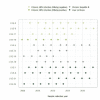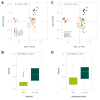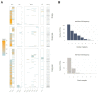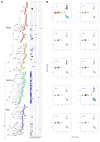Plasma virome dynamics in chronic hepatitis B virus infected patients
- PMID: 37228370
- PMCID: PMC10203228
- DOI: 10.3389/fmicb.2023.1172574
Plasma virome dynamics in chronic hepatitis B virus infected patients
Abstract
The virome remains an understudied domain of the human microbiome. The role of commensal viruses on the outcome of infections with known pathogens is not well characterized. In this study we aimed to characterize the longitudinal plasma virome dynamics in chronic hepatitis B virus (HBV) infected patients. Eighty-five longitudinal plasma samples were collected from 12 chronic HBV infected individuals that were classified in the four stages of HBV infection. The virome was characterized with an optimized viral extraction protocol and deep-sequenced on a NextSeq 2500 platform. The plasma virome was primarily composed of members of the Anello- Flavi-, and Hepadnaviridae (HBV) families. The virome structure and dynamics did not correlate with the different stages of chronic HBV infection nor with the administration of antiviral therapy. We observed a higher intrapersonal similarity of viral contigs. Genomic analysis of viruses observed in multiple timepoint demonstrated the presence of a dynamic community. This study comprehensively assessed the blood virome structure in chronic HBV infected individuals and provided insights in the longitudinal development of this viral community.
Keywords: anellovirus; blood; hepatitis B virus; metagenomic; pegivirus; plasma; virome.
Copyright © 2023 Thijssen, Tacke, Van Espen, Cassiman, Naser Aldine, Nevens, Van Ranst, Matthijnssens and Pourkarim.
Conflict of interest statement
The authors declare that the research was conducted in the absence of any commercial or financial relationships that could be construed as a potential conflict of interest.
Figures









Similar articles
-
Plasma Virome Reveals Blooms and Transmission of Anellovirus in Intravenous Drug Users with HIV-1, HCV, and/or HBV Infections.Microbiol Spectr. 2022 Aug 31;10(4):e0144722. doi: 10.1128/spectrum.01447-22. Epub 2022 Jun 27. Microbiol Spectr. 2022. PMID: 35758682 Free PMC article.
-
HIV-1 Infection Alters the Viral Composition of Plasma in Men Who Have Sex with Men.mSphere. 2021 May 5;6(3):e00081-21. doi: 10.1128/mSphere.00081-21. mSphere. 2021. PMID: 33952659 Free PMC article.
-
Clinical relevance of plasma virome dynamics in liver transplant recipients.EBioMedicine. 2020 Oct;60:103009. doi: 10.1016/j.ebiom.2020.103009. Epub 2020 Sep 24. EBioMedicine. 2020. PMID: 32979836 Free PMC article.
-
T-cell therapy for chronic viral hepatitis.Cytotherapy. 2017 Nov;19(11):1317-1324. doi: 10.1016/j.jcyt.2017.07.011. Epub 2017 Aug 25. Cytotherapy. 2017. PMID: 28847469 Review.
-
Insights Into the Role of the Lung Virome During Respiratory Viral Infections.Front Immunol. 2022 Apr 27;13:885341. doi: 10.3389/fimmu.2022.885341. eCollection 2022. Front Immunol. 2022. PMID: 35572506 Free PMC article. Review.
Cited by
-
Exploring the relationship between anellovirus load and clinical variables in hospitalized COVID-19 patients: Implications for immune activation and inflammation.IJID Reg. 2023 Sep 24;9:49-54. doi: 10.1016/j.ijregi.2023.09.005. eCollection 2023 Dec. IJID Reg. 2023. PMID: 37868342 Free PMC article.
-
Navigating Evolving Challenges in Blood Safety.Viruses. 2024 Jan 15;16(1):123. doi: 10.3390/v16010123. Viruses. 2024. PMID: 38257823 Free PMC article.
-
Genotypic Clustering of H5N1 Avian Influenza Viruses in North America Evaluated by Ordination Analysis.Viruses. 2024 Nov 22;16(12):1818. doi: 10.3390/v16121818. Viruses. 2024. PMID: 39772128 Free PMC article.
-
Characterization of the Human Blood Virome in Iranian Multiple Transfused Patients.Viruses. 2023 Jun 23;15(7):1425. doi: 10.3390/v15071425. Viruses. 2023. PMID: 37515113 Free PMC article.
References
LinkOut - more resources
Full Text Sources

